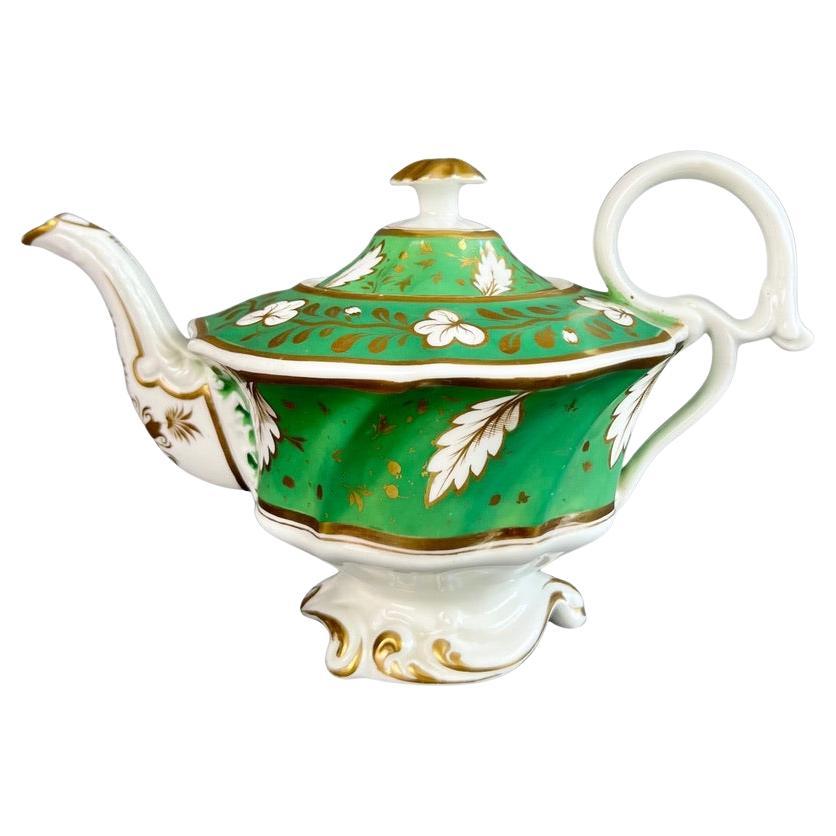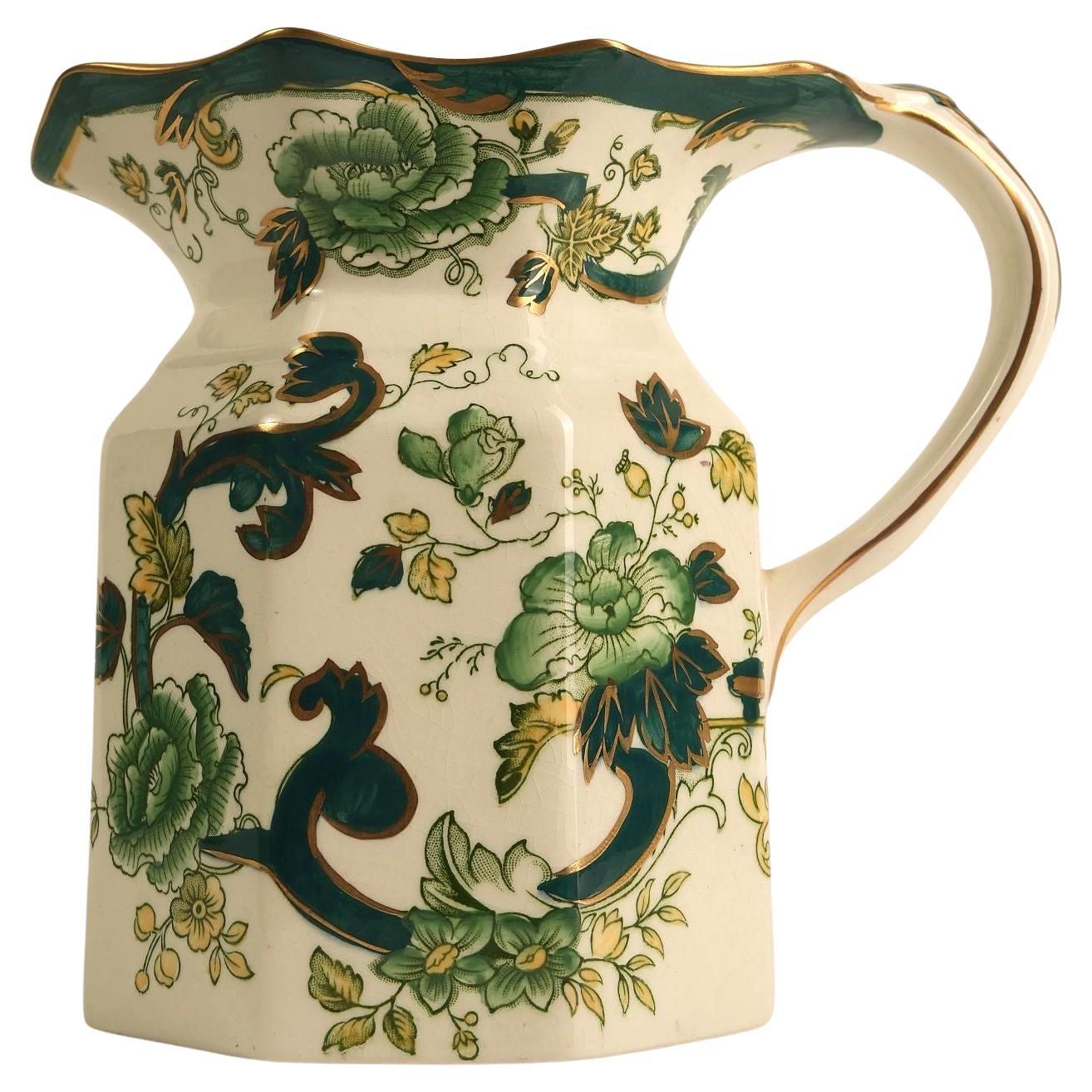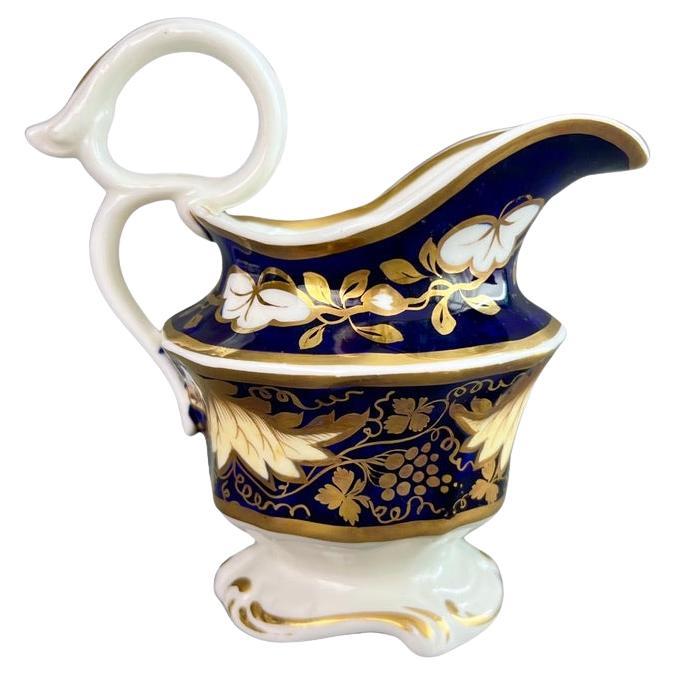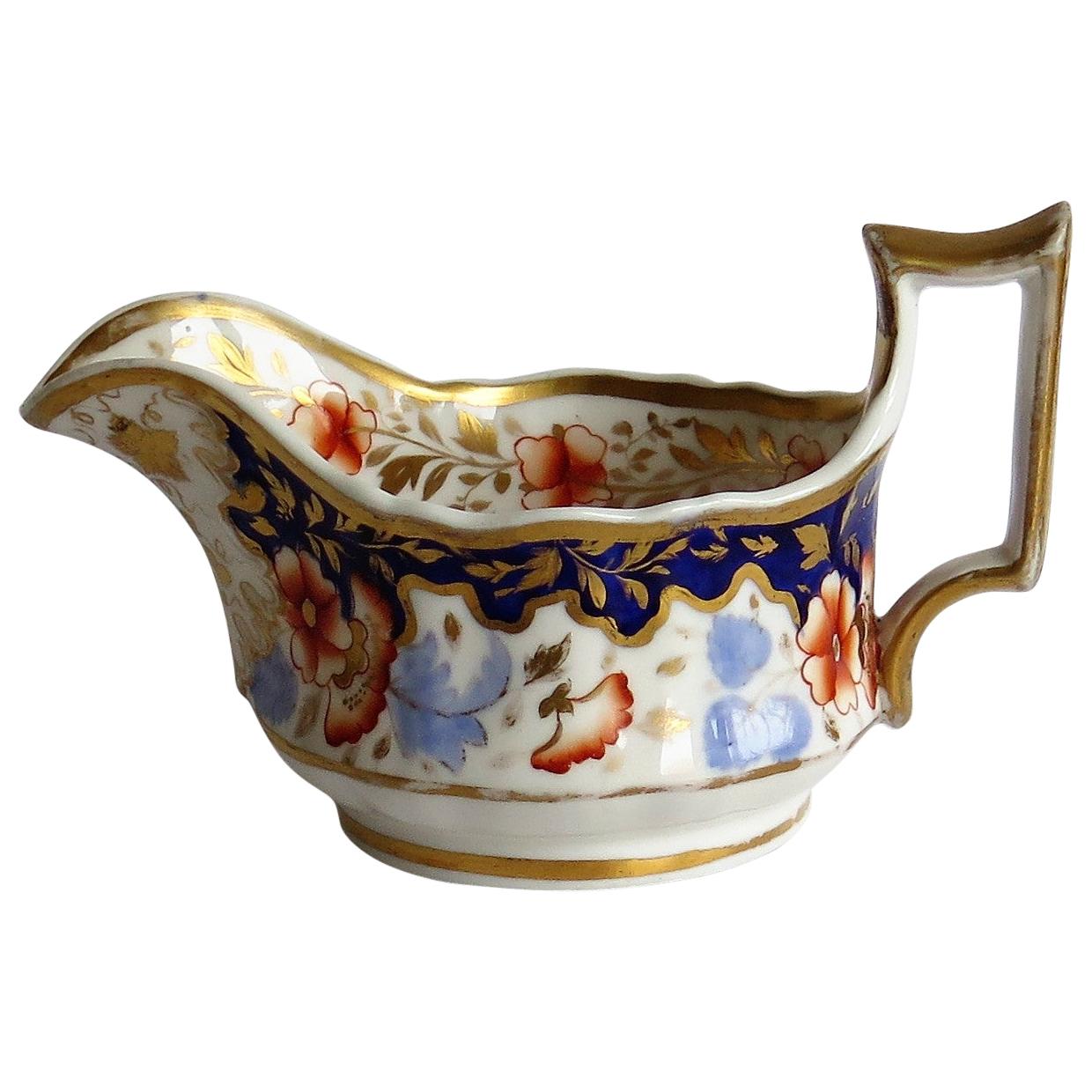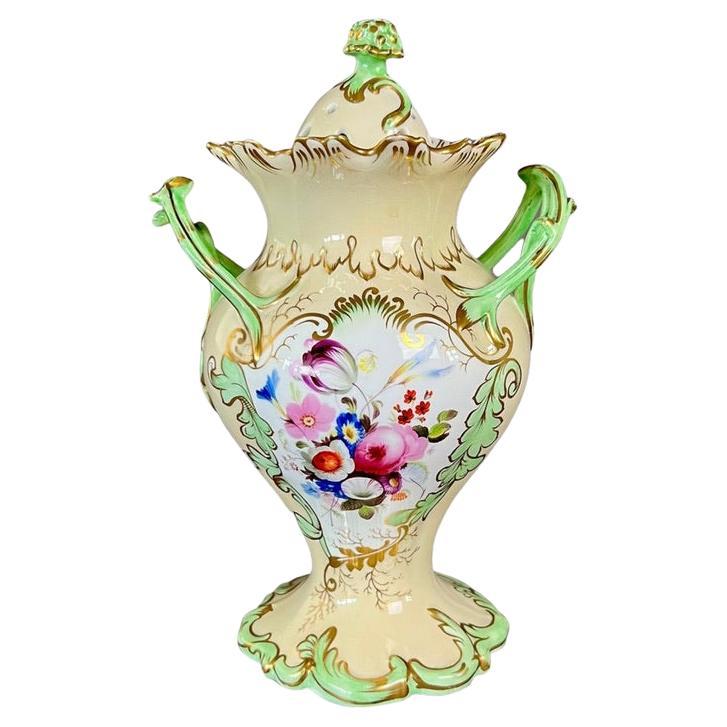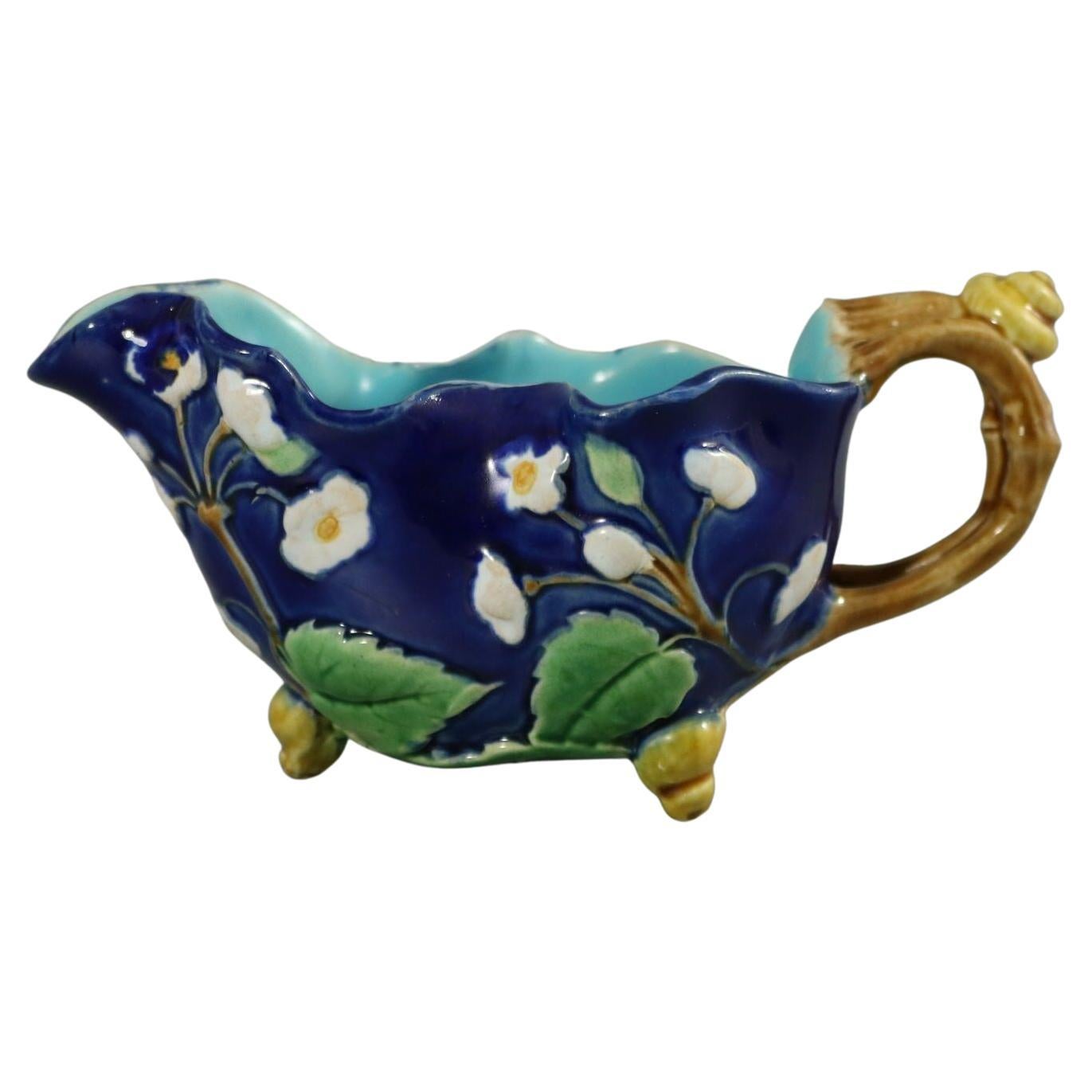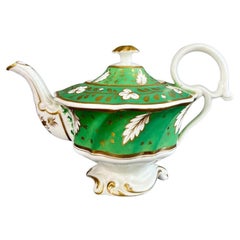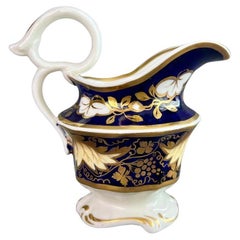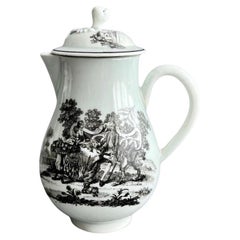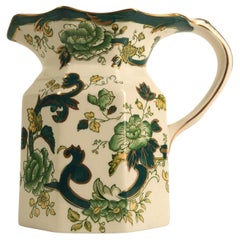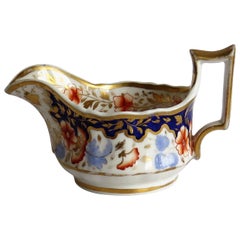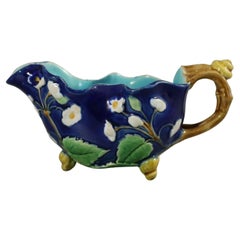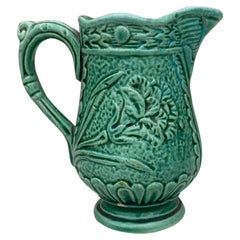Items Similar to Samuel Alcock Milk Jug Creamer, Emerald Green "Writhen" Shape, ca 1826
Want more images or videos?
Request additional images or videos from the seller
1 of 13
Samuel Alcock Milk Jug Creamer, Emerald Green "Writhen" Shape, ca 1826
$375
£288.10
€331.02
CA$527.48
A$592.60
CHF 309.64
MX$7,233.02
NOK 3,931.48
SEK 3,700.66
DKK 2,470.21
About the Item
A milk jug or creamer in the “writhen” shape, emerald green ground with white and pale yellow trailing florals.
We have a milk jug in a nearly identical pattern available, please see separate listing.
Pattern 2310
Year: ca 1826
Size: 28cm (10.25”) from handle to spout
Condition: perfect
The Samuel Alcock factory was operative in Staffordshire between 1822 and 1856, after which it was bought by Sir James Duke and Nephews. The factory started as a partnership between the young Samuel Alcock and the older Ralph Stevenson, who provided the factory and capital. Alcock quickly took the factory to great heights, building one of the biggest factories of its time. Alcock jumped on the new Rococo Revival fashion and served a huge new middle class market. The reason we now don't hear much about Samuel Alcock porcelain is that much of it has been mis-identified over the years and attributed to Coalport, Ridgway, Rockingham or others; Alcock did not mark any of his porcelain save a few rare pieces, and the numbering system is difficult to understand. However, the wares are still wide spread and many are of great quality.
This item forms part of the Murray Pollinger Collection of Samuel Alcock Porcelain. Most of the collection is not publicly available yet, but if you would like to get access to the first 100 lots, please sign up for our mailing list at the bottom of this page, and we will send you the full catalogue with more information, from which you can purchase more items.
Murray Pollinger was a passionate collector of Samuel Alcock porcelain. He was known as a true gentleman, impeccably dressed, always kind and modest - even some of his porcelain collecting friends had no idea about the size and importance of his collection. From the mid 1980s until shortly before his death in 2022 he collected many thousands of pieces and painstakingly catalogued them. He also went on trips to Staffordshire to discover the history of Samuel Alcock from whatever little documentation has been preserved. Through his painstaking work, Pollinger was able to make sense of the pattern numbering system that was used, and this was a huge step forward in identifying and understanding the porcelain. A website with the results of his research will be made availabe over the course of 2023. While he sold off about half of his collection in 2016, the remaining half is now made available to a new generation of collectors.
Antique British porcelain is never perfect. Kilns were fired on coal in the 1800s, and this meant that china from that period can have some firing specks from flying particles. British makers were also known for their experimentation, and sometimes this resulted in technically imperfect results. Due to the shrinkage in the kiln, items can have small firing lines or develop crazing over time, which should not be seen as damage but as an imperfection of the maker's recipes, probably unknown at the time of making. Items have often been used for many years and can have normal signs of wear, and gilt can have signs of slight disintegration even if never handled. I will reflect any damage, repairs, obvious stress marks, crazing or heavy wear in the item description but some minor scratches, nicks, stains and gilt disintegration can be normal for vintage items and need to be taken into account.
There is widespread confusion on the internet about the difference between chips and nicks, or hairlines and cracks. I will reflect any damage as truthfully as I can, i.e. a nick is a tiny bit of damage smaller than 1mm and a chip is something you can easily see with the eye; a glazing line is a break in the glazing only; hairline is extremely tight and/or superficial and not picked up by the finger; and a crack is obvious both to the eye and the finger. Etcetera - I try to be as accurate as I can and please feel free to ask questions or request more detailed pictures!
- Creator:Samuel Alcock & Co. (Maker)
- Dimensions:Height: 1 in (2.54 cm)Diameter: 1 in (2.54 cm)
- Style:Rococo Revival (Of the Period)
- Materials and Techniques:
- Place of Origin:
- Period:
- Date of Manufacture:circa 1826
- Condition:Wear consistent with age and use. minor rubbing, otherwise perfect.
- Seller Location:London, GB
- Reference Number:Seller: MP-ALC66b1stDibs: LU4805146137022
About the Seller
5.0
Vetted Professional Seller
Every seller passes strict standards for authenticity and reliability
Established in 2016
1stDibs seller since 2019
226 sales on 1stDibs
- ShippingRetrieving quote...Shipping from: London, United Kingdom
- Return Policy
Authenticity Guarantee
In the unlikely event there’s an issue with an item’s authenticity, contact us within 1 year for a full refund. DetailsMoney-Back Guarantee
If your item is not as described, is damaged in transit, or does not arrive, contact us within 7 days for a full refund. Details24-Hour Cancellation
You have a 24-hour grace period in which to reconsider your purchase, with no questions asked.Vetted Professional Sellers
Our world-class sellers must adhere to strict standards for service and quality, maintaining the integrity of our listings.Price-Match Guarantee
If you find that a seller listed the same item for a lower price elsewhere, we’ll match it.Trusted Global Delivery
Our best-in-class carrier network provides specialized shipping options worldwide, including custom delivery.More From This Seller
View AllSamuel Alcock Teapot, Emerald Green "Writhen" Shape, ca 1826
By Samuel Alcock & Co.
Located in London, GB
A teapot with cover in the “writhen” shape, emerald green ground with white and pale yellow trailing florals.
We have a milk jug in a nearly identical pattern available, please see ...
Category
Antique 1820s English Rococo Revival Porcelain
Materials
Porcelain
Samuel Alcock Milk Jug Creamer, Cobalt Blue, Gilt Vines, "Writhen" Shape, ca1826
By Samuel Alcock & Co.
Located in London, GB
A milk jug in the “writhen” shape, cobalt blue ground with white and pale yellow trailing acanthus leaves and vines.
We have a teapot with cover in the same pattern available, pleas...
Category
Antique 1820s English Rococo Revival Porcelain
Materials
Porcelain
Samuel Alcock Potpourri Vase, Green, Double Cover, Landscape, Flowers, ca 1835
By Samuel Alcock & Co.
Located in London, GB
A potpourri vase with double cover, pale yellow/beige ground with apple green details, Rococo shape with fruit finial and scroll handles and foot; a flower reserve on one side and a ...
Category
Antique 1830s English Rococo Revival Vases
Materials
Porcelain
$688 Sale Price / set
20% Off
Free Shipping
Worcester Milk Jug and Cover, Creamer, Monochrome Print Tea Party no.2, ca 1760
By 1st Period Worcester Dr. Wall
Located in London, GB
This is a very charming milk jug with cover made by Worcester in their First Period (sometimes called the Dr Wall Period) in about 1760. The items are decorated in a black overglaze ...
Category
Antique 1760s English George III Porcelain
Materials
Porcelain
$416 Sale Price / set
20% Off
Free Shipping
Samuel Alcock Porcelain Teapot, Blue, Gilt and Flowers, Rococo Revival ca 1837
By Samuel Alcock & Co.
Located in London, GB
A teapot with cover in the “rustic bean” shape, cobalt blue ground with gilt acanthus motif and finely painted flower posies on the belly of the teapot
Pattern 5782
Year: ca 1837
Si...
Category
Antique 1830s English Rococo Revival Tea Sets
Materials
Porcelain
$600 Sale Price
20% Off
Free Shipping
Samuel Alcock Sucrier, French Blue, Pear Shaped Rococo Revival, 1843
By Samuel Alcock & Co.
Located in London, GB
A pear-shaped Rococo Revival sucrier with cover, with a capricious design of French blue scrolls, peach and gilt wave cartouches, and beautifully hand painted flower sprays around th...
Category
Antique 1840s English Rococo Revival Porcelain
Materials
Porcelain
You May Also Like
Mason's Ironstone Jug in "Green Chartreuse" Pattern
By Mason's Ironstone
Located in Worcester Park, GB
This exquisite Mason's Patent Ironstone jug, adorned in the rare "Green Chartreuse" pattern, is a striking example of 19th-century English ceramic artistry. Known for its bold palett...
Category
Mid-20th Century British Romantic Pitchers
Materials
Ironstone
Ridgway Porcelain Milk Jug or Creamer Pattern 2/1005, Regency Period, circa 1825
By J & W Ridgway
Located in Lincoln, Lincolnshire
This is a very decorative, porcelain milk jug or creamer in the early Grecian shape, made by John and William Ridgway, of Shelton, Hanley, Staffordshire Potteries, England, dating to...
Category
Antique Early 19th Century English Regency Ceramics
Materials
Porcelain
Minton Majolica Cream Jug with Snail Handle
By Minton
Located in Chelmsford, Essex
Minton Majolica creamer which features a blossoming branch, snail shell on handle and feet. Cobalt blue ground version. Colouration: cobalt blue, gree...
Category
Antique 1870s English Victorian Pitchers
Materials
Majolica
Small French Green Majolica Pitcher Creamer circa 1900
Located in Austin, TX
Charming Small French Green Majolica Pitcher Creamer decorated with a carnation.
Category
Antique Early 1900s French Rustic Pitchers
Materials
Ceramic
Antique Art Pottery Green Ewer Probably Belgian, circa 1890
Located in Bishop's Stortford, Hertfordshire
A fine antique green glazed art pottery handled ewer with incised stylized floral designs picked out in black glazes with incised line designs around the body of the ewer. With mould...
Category
Antique Late 19th Century Belgian Folk Art Ceramics
Materials
Pottery
Franciscan by Gladding McBean El Patio Jug Carafe w/ Lid, Sea Mist Green 1930s
By Franciscan China 1, Gladding, McBean
Located in Clifton Springs, NY
Vintage Art deco style carafe or jug with lid features simple, clean design, the iconic “pretzel” shaped cup handle, and high gloss turquoise glaze. It's a part of El Patio line, attributed to Mary Grant, the first dinnerware line produced by Gladding McBean under their Franciscan Pottery division in 1934. The glaze color, Glacial Blue, is one of the first 8 glaze colorways for the line. El Patio line had three versions of the carafe – one with a wooden handle, one with a ceramic handle, and another with a metal holder; this carafe has the build-in ceramic handle, resulting in streamlined, monochromatic look.
The carafe is marked on the bottom with the oval GMCB mark that was in use from 1934 to 1938. The mark dates the piece to the earliest years of the production of El Patio, one of the five most important California solid colored dinnerware lines of the 1930s, alongside Pacific Hostessware, Bauer Ringware, Metlox 200 Series, and Vernon Kilns Early California.
The Gladding, McBean & Company, one of the biggest potteries in Southern California, was founded in 1875 in Lincoln, California. In 1934 the company began the manufacture of dinnerware and art ware under the trade name Franciscan Ware...
Category
Early 20th Century American Art Deco Porcelain
Materials
Ceramic, Pottery
